Flora gobica


Acroptilon repens
Description: Perennial plant of the Asteraceae family. Stems are ascendant, branched at the top, and covered with short hairs. Basal leaves are deeply lobbed and form a rosette. The stem leaves are alternate. The flowers form a terminal head. They are pink to purple with papery involucre bracts. It forms an wide rhizome that can extend over 2 m. deep.
Ecology and adaptation: A. repens can thrive in dry steppes and disturbed areas. It possesses a long tap root to absorb underground water. The root stores energy for early-season emergence.
Traditional usage: The plant contains repin, a neurotoxin that animals such as horses and bovids should avoid. Its presence usualliŷ indicates the nomads of an overgrazed pasture.


Allium sp.
Description: Perennial plants of the Amaryllidaceae family. Many species of Allium are growing in the Gobi Desert including Allium polyrhizum, Allium mongolicum, Allium bidentatum, and Allium tenuissimum. Leaves are Leaves linear or hollow, flat or terete, and usually basal. Inflorescences are terminal umbel, enclosed in a membranous spathe before blooming. Flowers are small, with six tepals (3 + 3), often white, pink, or purple, and six stamens. Fruits are capsules that include black seeds.
Ecology and adaptation: Allium species that grows in the Gobi can be found in desert steppes, dry grasslands, rocky slopes, and stony valleys. They usually grow in open and sunny locations. The bulb is a storage organ for water and nutrients. The narrow and often tubular leaves and the waxy cuticle minimize water loss through transpiration. The seeds are dispersed by gravity or wind in open areas. After germination, the aerial part focuses on photosynthesis and storing energy in the developing bulb. After approximately 3 years, once the bulb reaches a critical size and energy reserve, it initiates flowering. The plant can regrow vegetatively from the bulb.
Traditional usage: Leaves and bulb are cusumed in culinary. They are also used for their antibacterial and antiparasitic properties to cure digestive issues.


Anabasis brevifolia
Description: Plant belonging of the family of Amaranthaceae. It is a small perennial growing like a small bush with a maximum height of 30 cm. The stems are woody at the base and devid into many branches. Leaves are reduced to small succulent scales. They are opposite decussate. Small solitary flowers are located at the nodes.
Ecology: A. brevifolia grows in stony, gravelly soils. It tolerates saline and alcaline environments. It is usually found as a dominant species. Its presence helps stabilize the soil and support many herbivores.
Adaptation: Its reduced leaves prevent water loss through transpiration and its photosynthetic stems take over the leaf function. Its succulent stems and leaves store moisture. Its long root system allows access to deeper soil moisture. It is also tolerant to salin and alkaline soils. Its compact growth protects it against winds and sandblasting.
Traditional usage: It is a key forage plant for camel, goats, and sheep.


Androsace maxima
Description: Annual plant of the Primulaceae family. Short flowering stems. Basal rosette with lanceolate to oblanceolate hairy leaves. Flowers on a short peduncle, campanulate calyx, with pink-white 5-lobed corolla. The fruit is a spherical capsule enclosed by a persistent calyx. It splits to reveal small black seeds.
Ecology and adaptation: A. maxima grows in semi-arid steppes. The basal rosette minimizes water loss and wind exposure by keeping the leaves close to the ground. The reduced size of the leaves also contributes to preventing water loss. The plant has a short life cycle and can rapidly mature once moisture is available.
Traditional usage: Similar Androsace species have been used to cure fevers or inflammation.


Arnebia decumbens
Description: Annual plant of the Boraginaceae family. Stem covered with rough hairs. It can be branched from the base. Leaves are linear and also covered with rough hairs. The basal leaves are slightly broader than the upper leaves. Flowers are bright yellow with 5 lobes and a funnel-shaped-corolla.
Ecology: The plant grows in sandy, gravelly, rocky soils, often in open areas with full sun and minimal competition. The plant is short and often decumbent, thus reducing water loss from transpiration. The hairy surface prevents water loss too and reflects excess sunlight. It can quickly complete its life cycle as soon as some moisture is available. Nutlets are easily dispersed by wind or animals.
Adaptation: Its hairy leaves protect them against excessive solar radiation. The seeds germinate after rainfall and the plant quickly completes its life cycle. The rough surface of the fruit's nutlets helps anchor in soil or dispersion through small animals.
Traditional usage: The plant may be used as an anti-inflammatory.
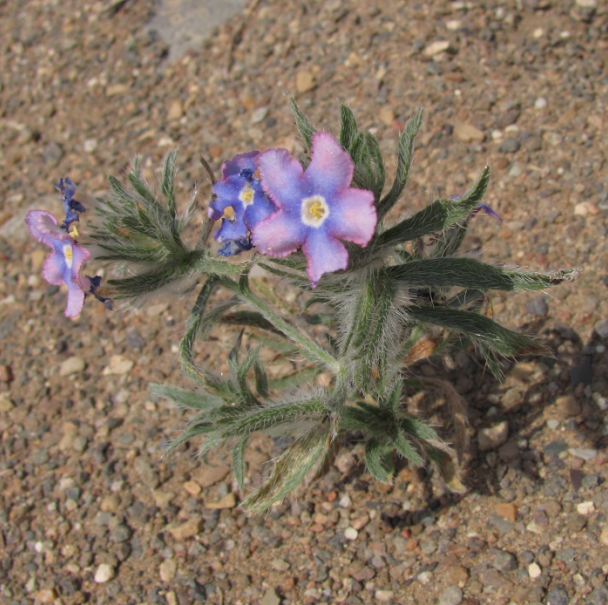
Arnebia fimbriata
Description: Annual plant of the Boraginaceae family. Stem covered with rigid, hispid, hairs. Leaves are simple, alternate, with entire margins, and densely hairy on both sides. Inflorescence with scorpioid cymes. Actinomorphic flowers with a belled shape and well defined 5-lobed corolla fringed at the tip, and 5 stamens. Schyzocarp fruits with 5 nutlets.
Ecology: A. arnebia grows in sandy, gravelly, or rocky plains of semi-arid to arid regions of Central Asia. It can thrive under direct sunlight exposure. Its bright yellow, purple bluish colored corolla attracts many pollinators.
Adaptation: Its hairy leaves protect them against excessive solar radiation. The seeds germinate after rainfall and the plant quickly completes its life cycle. The rough surface of the fruit's nutlets helps anchor in soil or dispersion through small animals.
Traditional usage: The plant is used against wounds in traditional medicine due to its anti-inflammatory properties.
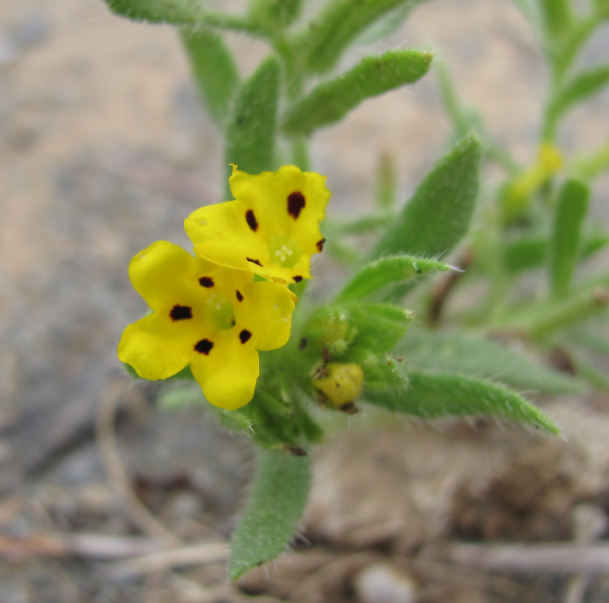
Arnebia guttata
Description: Annual plant of the Boraginaceae family. Stems are ascending, pubescent, and covered with stiff hairs. Leaves are alternate, simple, and lanceolate. They are densely covered with stiff hairs. The inflorescence has scorpioid cymes. They are composed of actinomorphic flowers showing a funneled shape and a well-defined 5-lobed corolla. The corolla is bright yellow with distinctive brownish spots at the base of each lobe. The fine stamens are attached to the base of the corolla. Fruits are dry schizocarps that divide into 4 nutlets.
Ecology and adaptation: A. guttata can thrive in dry steppes and sandy or gravelly soils. It can be part of the pioneer species on degraded lands, thus stabilizing the soil. Its dense hairs on leaves and stems reduce transpiration by reflecting sunlight. It can complete a short life cycle following rain events. Its bright yellow corolla with dark indicators may attract various pollinators.
Traditional usage: A. guttata is used as an anti-inflammatory agent. Its abundance can indicate a degraded pasture due to overgrazing.
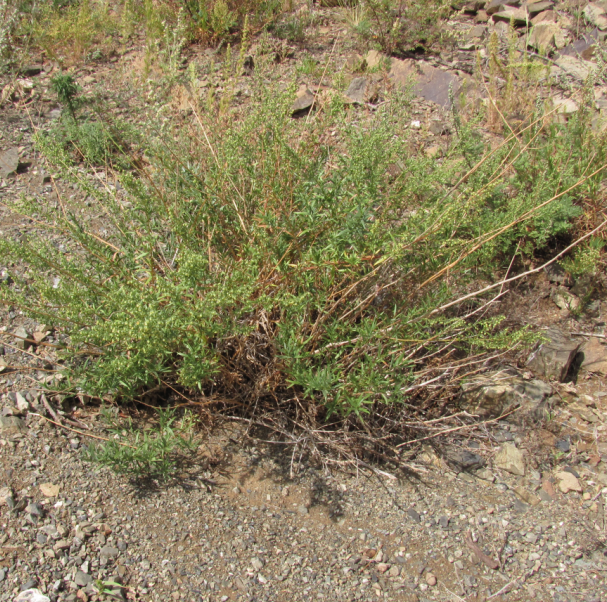
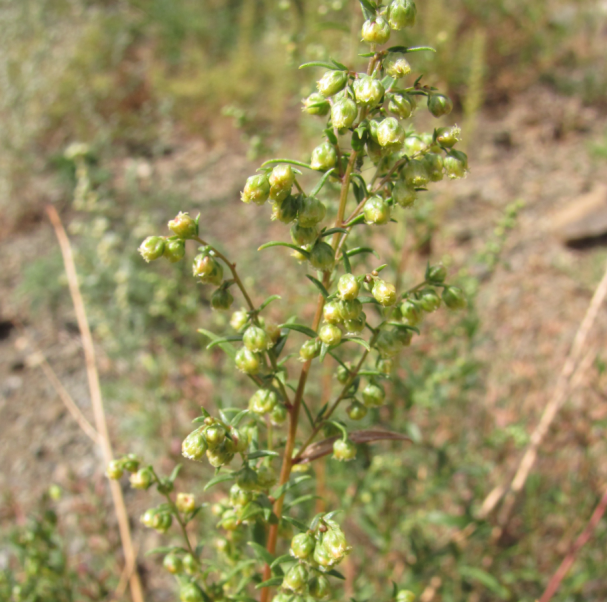
Artemisia dracunculus
Description: Perennial plant of the Asteraceae family. Stems are erect, slender, and branched, with a green to reddish color. Leaves are alternate, linear to lanceolate, and glabrous. Inflorescences are small and yellow capitula arranged in panicles. The fruits are small achenes.
Ecology and adaptation: A. dracunculus is found from Western Europe to Eastern Siberia, including Mongolia and the Gobi Desert. It grows well in semi-arid steppes and desert margins. Its reduced leaves and thick cuticle can minimize transpiration. It possesses a deep and extensive root system to access underground moisture. It can lose leaves and reduce metabolic activities during drought events. Its spreading architecture maximizes access to light while reducing impact from winds. It is wind-pollinated but can also reproduce vegetatively.
Traditional usage: The leaves can be consumed as a seasoning. It also stimulates digestion and relieves menstrual discomfort.


Artemisia xerophytica
Description: Dwarf shrub of the Asteraceae family. Stem with a woody base and often branched. The leaves are short, up to 1.5 cm., linear, entire or shallowly lobbed, thick or leathery, and gray-green. The inflorescences are compact racemes or panicles of small yellow tubular flowers. Achenes are small, dry, without pappus. They are adapted to fall near the plant so as not to be dispersed by the wind.
Ecology and adaptation: A. xerophytica is almost exclusively found in deserts. It grows in gravelly plains, dunes, rocky slopes, and desert steppes. The long root system allows access to moisture deep below the surface. The leathery and linear leaves reduce surface area and transpiration. The woody stem base protects against the wind, grazing, and the cold. The foliage is evergreen allowing photosynthesis all the year.
Traditional usage: The woody base can serve as fuelwood. Also, its wide root system stabilizes the soil and reduces erosion..
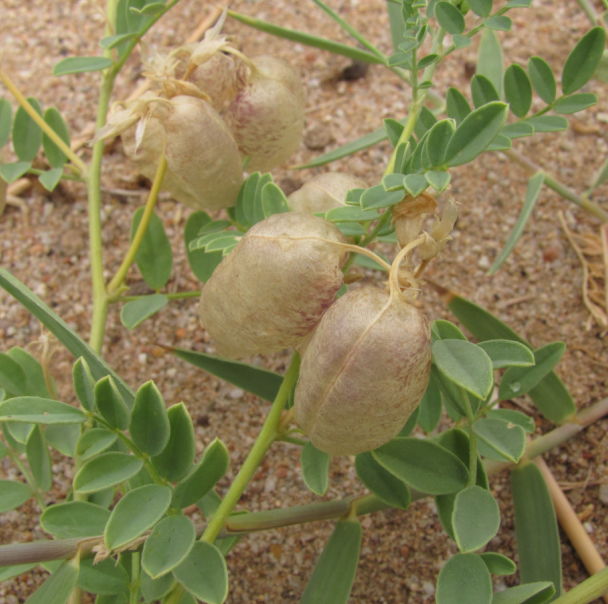
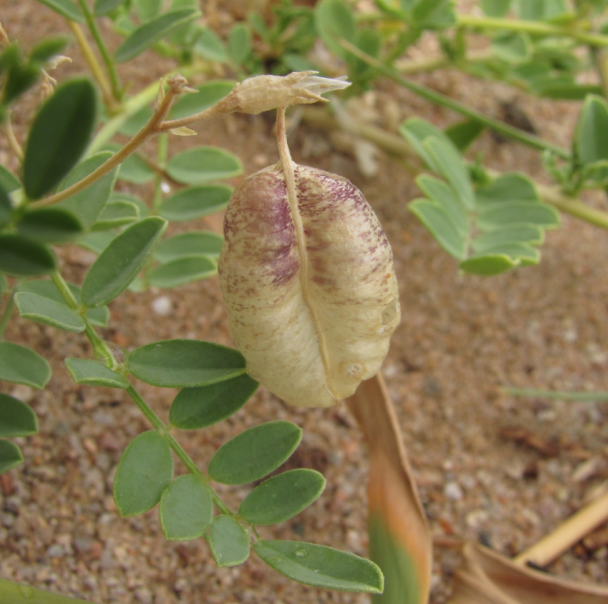
Astragalus mongholicus
Description: The plant in the picture is an Astragalus species adapted to the Gobi Desert, similar to A. mongholicus or A. altaica. They are perennial plants of the Fabaceae family. Leaves are pinnately compound with about 4 pairs for A. altai-gobicus and up to 14 pairs in case of A. altaicola. The leaflets are obovate to elliptic. The flowers are papilionaceous and arranged in a raceme. The pods are inflated legume-type fruits.
Ecology and adaptation: A. mongholicus grows in sandy or gravelly soils of semi-arid to arid regions. The plant can survive direct sunlight exposure. The taproot system allows access to deep underground moisture. Its yellow-colored petals attract many pollinators. Its extended root system can help to stabilize the soil. As a legume, it also enriches soils with nitrogen.
Traditional usage: A. membranaceus is known in Chinese traditional medicine to boost immune system and improve digestive function.

Astragalus monophyllus
Description: Perennial plant of the Fabaceae family. Leaves are growing in rosette from the base of a short stem. The stipules are ascendant longer than the leaves and covered with hair. The leaves are simple or composed of 3 leaflets. They are elliptic to obovate and covered with long, white, and sparse hairs on both surfaces. The flowers are yellow to orange, zygomorphic, elongated, with 5 tubular hairy sepals ended by a spike, 5 petals, and 10 stamens. They are racemic and clustered on top of a naked stem. The fruit is a legume covered with white hairs.
Ecology: A. monophyllus grows in sandy, gravelly, or rocky plains of semi-arid to arid regions. The plant can survive direct sunlight exposure. Its yellow-colored petals attract many pollinators. Its extended root system can help to stabilize the soil.
Adaptation: The hairy surface of the leaves protects them against excessive solar radiation. Its long tap root allows access to deep underground water.
Traditional usage: Species of Astragalus are widely in traditional medicine. However, there are no records for A. monophyllus.


Atrapaxis spinosa
Description: Perennial shrub of the Polygonaceae family. The stems are woody, often ending in spines and greyish to light brown color. The branching is rather dense. The plant can grow up to 60 cm tall and 180 cm wide. The leaves are obovate to elliptical, rather glabrous or slightly pubescent, dark green, and with an entire margin. The flowers form small axillary clusters. Their corolla is tubular with a white to reddish color. Tepals are persistent with 2 large and roundish inner sepals.
Ecology: A. spinosa grows in sandy or rocky soils of semi-arid to arid regions. Its extensive root system helps stabilize the soil and prevent erosion.
Adaptation: Its extensive root system can grow deep to access underground moisture. The short leaves' surface and thick cuticle can prevent excessive water loss by transpiration. It also possesses sucken stomata which create a more humid environment around it. Less water will then evaporate from the plant.
Traditional usage: The plant is used in traditional medicine to treat gastrointestinal disorders such as diarrhea, indigestion, and stomachaches. It is also used for its anti-inflammatory properties to reduce arthritis and joint pain.


Calligonum pumilum
Description: Perennial small shrub of the Polygonaceae family. The stems form a dense network of embranchements. Stems are photosynthetic with scale-like, nearly sessile, leaves. The flowers are small, pinkish-white, with 5 perianth segments. They occur solitary in the axils. The fruits are akenes with a surronding persistant periant.
Ecology and adaptation: C. pumilum grows in sandy dunes and sandy or gravelly plains. It is often found in association with saxaul trees. It possesses a deep tap root system to absorb underground water. Its short and scaly leaves help prevent excess water loss through transpiration. Its short size and dense branching network, growing close to the ground, protect the plant against sandstorms. It is often growing as a pioneer species. The long and fibrous root system contributes to stabilizing the sand.
Traditional usage: The plant can be used as an agent to stabilize the soil against desertification or for pasture restoration.

Cancrinia discoidea
Description: Annual plant from the Asteraceae family. Stems are erect, branched near the base, covered with short hairs. Leaves are alternate, lanceolate to oblong, tomentose, covered with hairs. Inflorescences are solitary capitula found at the end of the branches. Flowers are yellow without ligules.
Ecology and adaptation: C. discoidea grows in gravel plains, rocky slopes, or dry valleys. The tomentose leaves help reduce water loss during transpiration and reflect the sunlight. The tap root system allows access to deep soil moisture. It is a pioneer plant in disturbed land and overgrazed pasture.
Traditional usage: The dried aerial parts are infused to treat liver-associated diseases. They can also be used for their expectorant properties against bronchitis.
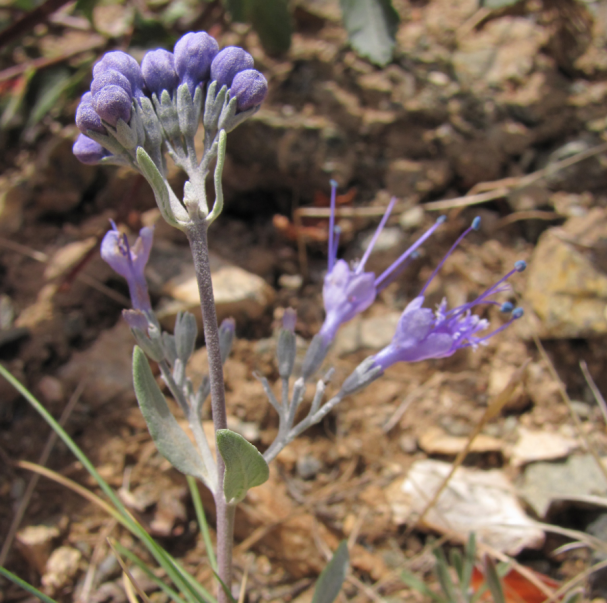

Caryopteris mongholica
Description: Deciduous plant of the Lamiaceae family. The stem is erect, semi-woody, and branched at the base. The leaves are opposite, lanceolate to ovate, and pubescent. The inflorescence is arranged in terminal clusters. The flowers are bilabiate with the lower lip larger than the upper lip. They are blue-purple with 4 stamens.
Ecology and adaptation: C. mongholica grows in valleys and on sandy soil. The deep root system helps access deeper moisture layers. The small and hairy leaves reduce water loss via transpiration. The woody base allows it to survive winter cold and summer drought. The flowers provide nectar resources for desert pollinators, especially butterflies. The plant is browsed by livestock, particularly sheep and goats. It functions as a pioneer species in disturbed environments, thus fixing soil.
Traditional usage: The plant was used in Chinese medicine for edema and dyspepsia. It is also known for its anti-inflammatory or tonic properties.


Cistanche deserticola
Description: Perennial plant from the Orobanchaceae family. It is a holoparasitic plant that lacks chlorophyll and is entirely dependent on its host plant. Its stem is erect, succulent, yellowish, brown to purple. An underground haustia connects to the host roots. The leaves are reduced to scale-like brownish bracts. They are placed along the stem. The inflorescence forms a dense terminal spike covered with bracts. The flowers are bilabial with 4 stamens. They produce small capsules-like fruits that contain numerous seeds.
Ecology and adaptation: C. deserticola grows in sandy soils in association with Haloxylon ammodendron, Haloxylon persicum, or Anabasis spp. The thick stem acts as a succulent water reservoir to survive during episodes of drought. The small numerous seeds allow a wide dispersal through wind giving a better chance for some to germinate close to a potential host. The plant matures quickly in spring to benefit from the humidity present during this season.
Traditional usage: The plant is traditionally used for its tonic effect, to enhance kidney and reproductive health, or as an aphrodisiac.


Convolvulus ammannii
Description: Perennial plants of the Convolvulaceae family. Leaves linear to lanceolate, stem without tendrils. Solitary flowers with a trumpet-shaped corolla of about 2 cm in diamètre. Petals light blue or lilac.
Ecology: It grows on sandy, gravelly, dry semi-desert steppe. It flowers rapidely after rainfall and quickly complete its life cycle. Its seeds remain viable for a long time wainting for the right conditions to germinate. It is pioneer plant helping to stabilize soil and providing microhabitats for many insect species.
Adaptation: Convolvulus ammannii possesses a long taproot system to reach deep underground moisture. It enables it to survive through prolonged dry periods. Its narrow and linear leaves minimize surface area, reducing water loss through transpiration. Their rolled edges and pubescent surfaces trap moisture. Also, their silver-green color reflects the sunlight. The plant grows close to the soil surface to keep the soil moisture and prevent direct contact with the wind.
Traditional usage: The aerial parts of the plant can be infused against gastrointestinal issues such as bloating or constipation. It is also used as a detoxifying agent in traditional medicine.


Dracocephalum foetidum
Description: Perennial plant of the Lamiaceae family. The stem is erect, ascending, and quadrangular. Leaves are opposite, oblong to lanceolate, and deeply serrated. The inflorescence is terminal or racem. The flowers are violet to purple, zygomorphic, with 2 lipped-opening and a long tubular corolla. The calix is densely hairy. The fruits are nutlets.
Ecology and adaptation: D. foetidum is spread in all of Mongolia, including the Gobi Desert. It grows in dry rocky slopes, gravel plains, mountain steppes, and desert steppes. The taproot system can absorb underground water. The hairy leaves prevent excess water loss by transpiration. It is also possible that its essential oil serves as UV protection.
Traditional usage: The plant is used for its digestive, anti-inflammatory, and antiseptic properties. It is brewed into tea to relieve colds or stomach ailments.


Echinops gmelinii
Description: Perennial thistle-like plant of the Asteraceae family. It can grow up to 80 cm. Robust stem branched at the top. Leaves sessiles, alternates, devided into lobes and with spiky margins. Leaves with tomentose surface covered with whitish hairs. Inflorescences are spherical solitary capitules located on top of the stem. Flowers are tubular, blue to violet, and hermaphrodites. Fruits are cypsela ending with a cap of hairy pappus.
Ecology: E. gmelinii grows in mountain foot-hills, rocky slopes, or dry valleys of semi-arid to arid regions. It tolerates saline, alkaline, and nutrient-poor soils. Its spiny foliage protects it from herbivores and grazing animals.
Adaptation: Its grayish hairy leaves and stems reflect the sunlight thus reducing water loss. Its deep taproot system allows access to deeper moisture in dry and often rocky soils. Its spherical capitules protect the internal flowers from dry winds. The plant can grow rapidly during summer and then become dormant during the cold season.
Traditional usage: The plant has been used in infusions or topical pastes made from roots or aerial parts to cure joint pain, rheumatism, and neuralgia.

Ephedra przewalskii
Description: Perennial plant of the Ephedraceae family. Its stems are tough, green, capable of photosynthesis, jointed, and often whorled. The leaves are reduced to tiny scales at the nodes. They are opposite or whorled and useless for photosynthesis. It is a dioecious species where male and female reproductive organs are in separate plants. The male cones are small, yellowish with multiple microsporophylls. The female cones are with small fleshy bracts maturing into cones-like structures that contain 1 or 2 seeds.
Ecology and adaptation: E. przewalskii grows in dry stony slopes, alluvial fans, and gravelly plains. Its deep taproot allows deep water absorption. Its reduced leaves prevent water loss by transpiration and its photosynthetic stems take it over. This plant tolerates harsh summers and cold winters and its stems remain active during all seasons. The stems contain particular cellular structures that accumulate soluble sugars and antifreeze proteins, which lower the freezing point of cell sap and stabilize membranes. That prevents damage caused by ice crystals forming inside the cells. It also allows the stems to remain photosynthetically active even though at a slower pace. Its woody base and root system anchor the plant against strong winds.
Traditional usage: The dried aerial parts of the plant are infused to treat respiratory issues such as bronchitis, cough and fevers. It is also used to improve the circulatory system.
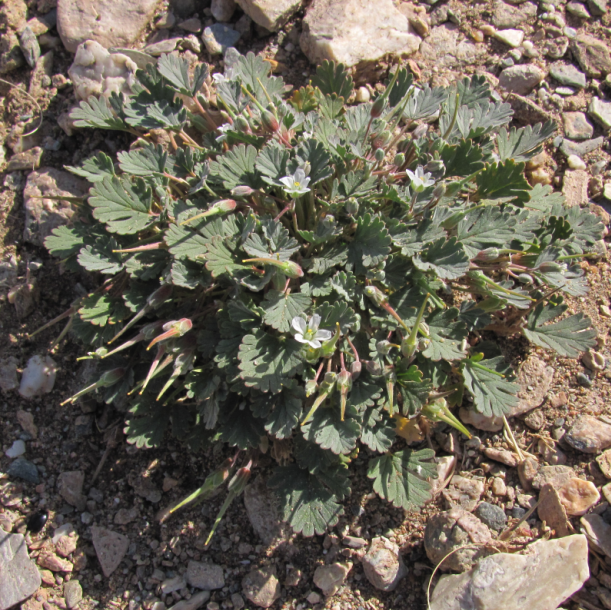
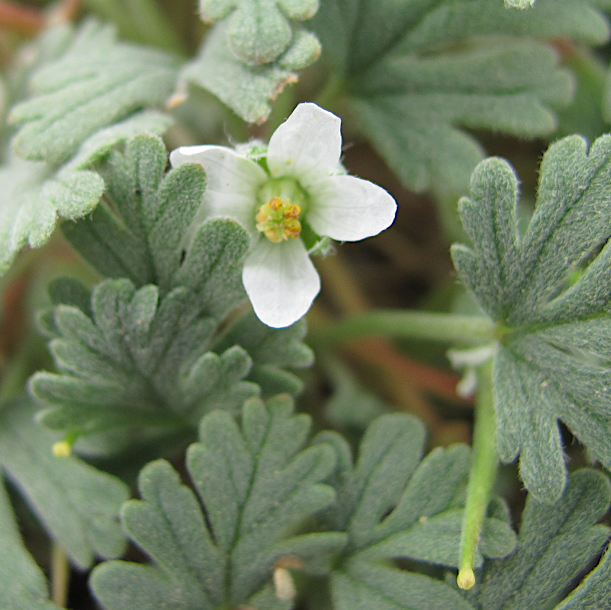
Erodium tibetanum ou oxyrhinchum
Description: Annual or biannual plant of the Geraniaceae family. Basal leaves pinnately divided or lobbed forming a compact rosette. Leaves surface pubescent. Small zygomorphic flowers with 5 petals and 5 sepals. Long fruits that splits into 5 mericarps. Seeds with coils.
Ecology: The basal leaf rosette grows near the ground, reducing exposure to wind, sandblasting, and minimizing water loss.
Adaptation: Its leaf trichomes trap moisture from dew and reduce transpiration. It relies on a brief life cycle, growing quickly when moisture is available, producing seeds, and dying off when dry. Seeds are dispersed by the wind. Their coiling shape allows them to self-drill into the soil when moistened. This is an effective strategy in the sandy soils of the Gobi.
Traditional usage: Erodium tibetanum may be infused as a herbal tea to help with stomach pain or inflammation.

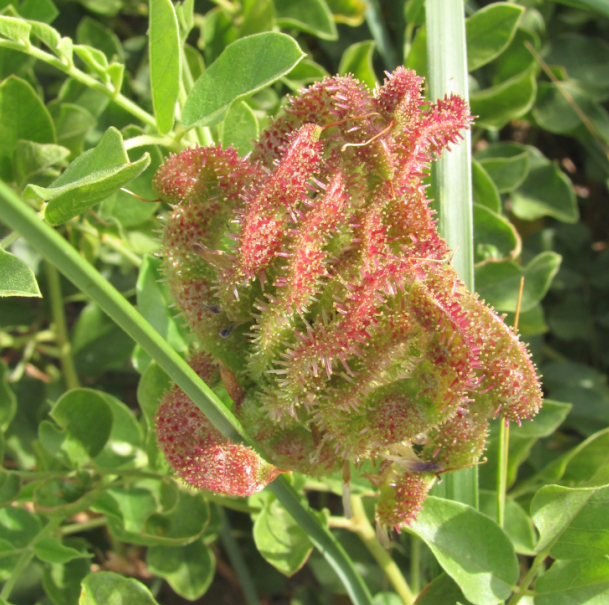
Glycyrrhiza uralensis
Description: G. uralensis is a perennial plant from the Fabaceae family. Its leaves are pinnately compound with 7–17 ovate to oblong leaflets 2–5 cm long and pubescent on the underside.
Ecology:It grows in sandy loamy soil. Its extensive root system helps to stabilize the soil. It can spread through clonal propagation. Its vast network of rhizomes helps spread and regenerate the colony. It also contributes to nitrogen fixation in soil.
Adaptation: Its deep taproot allows access to groundwater. The rhizomes can also store carbohydrates and water, allowing survival during droughts.
Traditional usage: The roots are boiled to form a decoction used against sore throat and pulmonary infection.

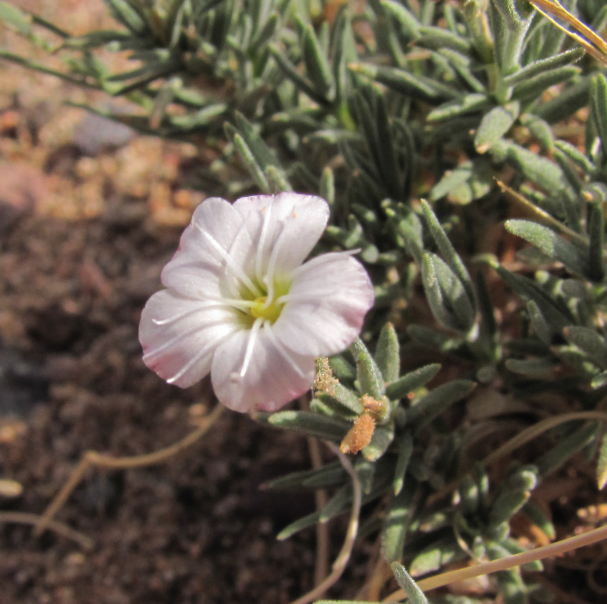
Gypsophila desertum
Description: G. desertum is a perennial plant from the Caryophyllaceae family. Stems are woody at the base, erect, and form a cushion mat. Leaves are opposite, sessile, linear, and tomentose. Flowers are actinomorphic, pinkish-white, 5 deeply lobed petals, and with 10 stamens nearly as long as the petals. The fruits are capsules containing numerous light seeds.
Ecology and adaptation: The plant grows in semi-arid to arid steppes, gravel plains, or mountain-desert slopes. Its compact cushion architecture reduces surface exposure to wind and sunlight. The small tomentose leaves prevent excess water loss by transpiration. The succulent tissues of the roots and stems store water during moisture events. The plant relies on the CAM (Crassulaceae Acid Metabolism) strategy to switch the photosynthesis timing and maintain the stomata close during the day thus minimizing water loss by transpiration. The deep root system provides access to underground moisture and anchors the plant in sandy soil. The hairy surface of the leaves can reflect sunlight. It also produces an antifreeze compound to sustain cold temperatures. The flowers are insect-pollinated. Their nectar supports the many insect's life cycle. The light seeds are dispersed by wind.
Traditional usage: The dried plant can be infused to treat coughs and other respiratory issues. Its bitter compounds stimulate digestion and heal stomach ailments. The plant is an indication of accessible groundwater.
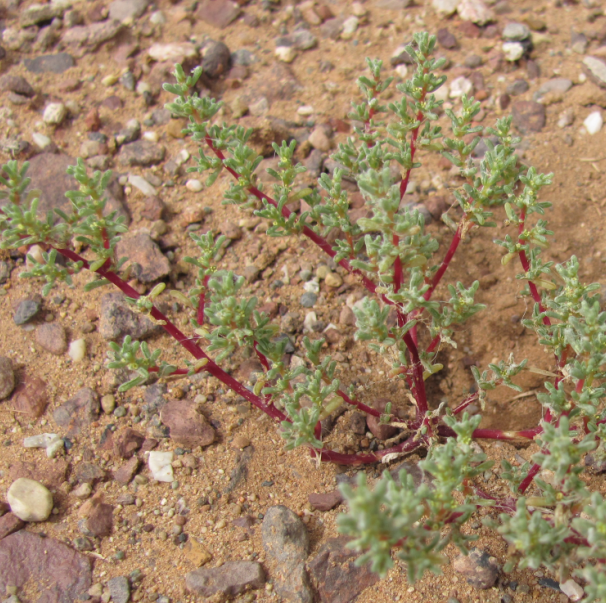
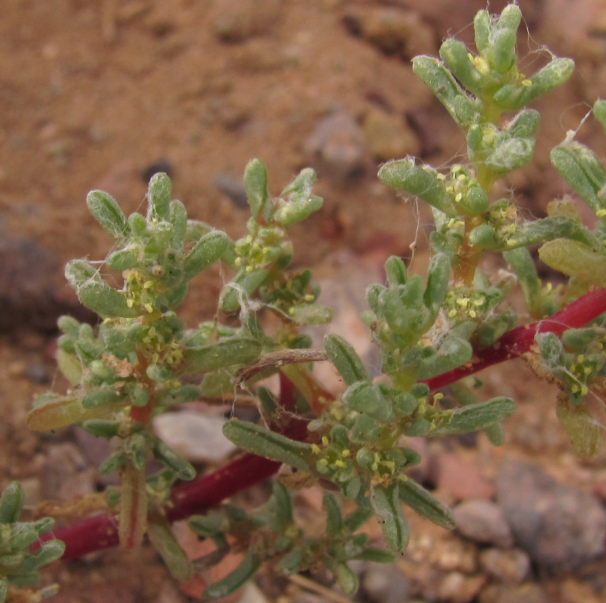
Halogeton glomeratus
Description: Perennial plant of the Amaranthaceae family. The stem is highly branched, often reddish to purple. Leaves are alternate, cylindrical, and succulent. The flowers are small, greenish to yellow, clustered in the axils of leaves. Each flower produces a small uricle.
Ecology and adaptation: H. glomeratus grows in saline depressions, alkaline soil, and dry riverbeds. The plant is well adapted to saline and alkaline environments. The succulent leaves help store water. It contains a high concentration of oxalate to balance the concentration of salts and reduce its toxicity. Its seeds are dispersed by wind. Mature plants may also detach and roll with the wind, thus spreading the seeds.
Traditional usage: This plant isn't favored by the nomads due to its high concentration of dissolved oxalate which is toxic for many animals.


Haloxylon ammodendron
Description: Perennial woody small tree of the Amaranthaceae family. The stem is woody, contorted with age, and with a greyish to brown bark. The leaves are reduced to short fleshy scales. Most of the photosynthesis occurs in the green stems. The flowers are small, inconspicuous, without petals, greenish to yellowish, and arranged in dense axillary clusters. The fruits are small utricles that develop wings-like structures. The root system includes a deep tap root of a few meters long and an extensive lateral roots of few meters wide.
Ecology and adaptation: H. ammodendron grows in Central Asian deserts. It is well adapted to live in arid, saline, and sandy soils with extreme temperatures. Its extensive root system, reaching a dozen meters wide and deep, can access soil moisture from a very wide area. Its reduced leaves minimize water loss through transpiration, and the green stems take over most of the photosynthesis. It can sequester salts in its tissues and extract the excess. Its dense woody stems protect the plant against strong winds. Pollination is primarily carried out by the wind. The winged fruits are dispersed by the wind to colonize desert dunes.
Traditional usage: Dry branches of H. ammodendron are used as fuelwood. This very dense wood burns with intense heat for a long time. It has also been used to make some instruments, such as the traditional whip. It has also been employed to treat digestive disorders, respiratory issues, and skin conditions.


Juniperus sabina
Description: Aromatic evergreen shrub of the Cupressaceae family. Low-growing, shrublike conifer typically under 2 meters in the Gobi, although it may reach up to 4 meters in more favorable mountain habitats. The leaves are dimorphic. Juvenile leaves are needle-like and sharp and adult leaves scale-liked overlapping and pressed closely to the twig. The plant is dioecious where male and female cones grow on separate individus. The female cones are round, berry-like, blue-black, about 7 mm in diameter, and containing 1–3 seeds. The male cones are small, yellowish, shedding pollen in spring.
Ecology and adaptation: J. sabina is native to Central Asia, Europe, Siberia, and Mongolia. It grows in dry rocky slopes, gravel plains, talus, and semi-arid mountain zones. Its woolly covering reflects sunlight and reduces transpiration. Its perennial root system allows rapid regrowth after dry seasons.
Traditional usage: Juniper branches are reduced into powder and burned as incense. Its smoke is considered sacred during Buddhist and shamanic rituals. It is believed to purify the space from evil spirits and to honor deities or nature spirits.


Kalidium foliatum
Description: Small perennial shrub of the Amaranthaceae family. The stems are cylindrical, joined, fleshy, and bluish to green. The leaves are lanceolate, cylindrical, alternate, and reduced to scale-like structures. The flowers are tiny, inconspicuous, and enclosed by fleshy bracts. They are arranged in axillary cymes. The fruits are utricles enclosed in the perianth, often winged. There is one seed per fruit.
Ecology and adaptation: K. foliatum is found in saline and alkaline depressions, dry lakebeds, and semi-desert steppes. The thick and reduced leaves minimize water loss. They function primarily as salt-storage organs rather than photosynthetic structures. The salt is sequestrated and extracted to avoid its poisonous effect. The thick stems take over photosynthesis. The plant proceeds with the CAM (Crassulaceae Acid Metabolism) strategy to undergo photosynthesis. It means that its stomata open only during the night to capture CO2 and minimize water loss. The stem stores water from rare moisture events. The flowers are shielded by thick bracts, which protect them against the wind, desiccation, and sunlight.
Traditional usage: Due to its ability to process salt, K. foliatum finds a lot of ethno-medical applications. The young plant is infused to treat digestive disorders. An herbal preparation is used to support kidney function. Crushed stems are applied externally to treat wounds. The presence of K. foliatum, or similar species, indicates a high salinity level of the groundwater.

Krascheninnikovia ceratoides
Description: Perennial plant of the Araranthaceae family. It is a small rounded shrub with multiple ascending stems. Stems are covered with wooly hairs. Leaves are opposite linear to lanceolate, tomentose, covered with whitish hairs. Flowers are unisexual, lacking petals, and enclosed in hairy bract. Male flowers are in clusters and female flowers are solitary in leaf axils. Fruits are urticles enclosed in hairy bracteoles adapted for wind dispersal of their seeds.
Ecology: Plants growing in dry, alkaline, or sandy soils. They play an important in preventing desertification due to its fibrous root system that stabilizes soil.
Adaptation: The hairy surfaces of its leaves help reflect sunlight, conserve water, and protect from wind and sand abrasion.
Traditional usage: K. ceratoides is one of the most valuable winter fodder plants in the Gobi as it retains nutritional value during the cold months.


Lagochilus ilicifolius
Description: Perennial plant of the Lamiaceae family. The stem is ascendant with a pale green color, and covered with short stiff hairs. Leaves are rhomboids ending with 3 to 5 short teeth, each with a short spine. Axiliary inflorescence with 2-4 flowers. The bracts are glabrous, divided into spines, and standing upright. The calyx has a tubular bell shape. It is green to white, glabrous, and mucronate. The corolla has a white color with purple-brown venation. It is bilobed and covered with dense hairs on the outside. It contains 4 stamens, 2 long and 2 short.
Ecology: The plant grows in sandy soil and the gentle slopes of semi-arid deserts. The woody perennial root system stabilizes the soil and allows regrowth after droughts. Its flowers bloom later in the season to match its pollinators' life cycle.
Adaptation: The leaf's thick cuticle and spines at the top prevent water loss by transpiration and deter herbivores. The dense hairs on the outside of the corolla could serve as protection against solar radiation.
Traditional usage: The plant has been used traditionally as an hemostatic agent to stop bleeding. It also possesses anti-oxidant and anti-inflammatory properties.


Limonium bicolor
Description: Perennial plant of the Poligonaceae family. Its architecture is composed of a deep woody taproot, a rosette, and multiple flowering stems. The leaves are linear to spatulate, leathery, and succulent. The inflorescence forms a panicle cyme with many small flowers. The flowers have a white membranous calyx and yellow or lilac corolla. The fruits are small and lightweight achenes.
Ecology and adaptation: The plant is well adapted to a saline environment. It grows on saline and alkaline soils, semi-desert steppes, and dry lake beds. It possesses specialized glands to excrete the excess salt. The thick leaves prevent water loss by transpiration, and the deep taproot system allows access to deeper underground water. It has a perennial life cycle and therefore can survive an episode of drought to regrow when conditions are more favorable. The plant can also propagate vegetally from the root base. This is also a pioneer species that contribute to soil stabilisation.
Traditional usage: The plant is used traditionally kidney and urinary ailments.


Linum salsoloides
Description: Perennial of the Linaceae family. Dwarf plants densely branched and forming compact mats. Stems are numerous, thin, erect, and growing from a woody root system. Leaves are sessile, alternate, linear, shorter than 2 cm. Flowers made with white to yellow 5 petals and 5 stamen. Fruits are ovoid capsules splitting into 10 valves.
Ecology: L. salsoloid grows in arid steppes of the Gobi Desert. It is found in saline, calcareous soils, rocky, disturbed landscapes, and eroded hillsides.
Adaptation: Its short, reduced, thin leaves decrease surface area thus minimizing water loss. Its waxy cuticle prevents loss of moisture by transpiration. The compact growth diminishes the sun and heat exposure. It possesses a long root system to access deep water. The plant can enter dormancy during prolonged dry season or drought.
Traditional usage: L. salsoloides is not a major medicinal plant.

Lycium sp.
Description: L. barbarum, L. ruthenicum, and L. chinense are perennial plants of the Solanaceae family. They are small deciduous shrubs growing up to 1 to 2 meters. Stems are ligneous, long, and often arching with spines present at the axils. Leaves are fleshy lanceolate to ovate. Flowers are solitary or in small groups, funnel-shaped, pink, pale purple, or violet. The fruits are small and juicy berries. The fruits of L. barbarum and L. chinense are red whereas those of L. ruthenicum are black.
Ecology and adaptation: Those Lycium species grow well on gravel deserts, dunes, dry stream beds, and saline depressions. Their long root system allows them to access deep underground water. The reduced leaves equipped with thick cuticles prevent excessive water loss through transpiration. The long spines close to the leaves protect them against herbivores. Their fleshy fruits provide food to many animals and birds which in turn helps with seed dispersal.
Traditional usage: Lycium berries are comestibles and rich in anti-oxidants and antiocyanin. They are consumed fresh or dried as a general tonic.

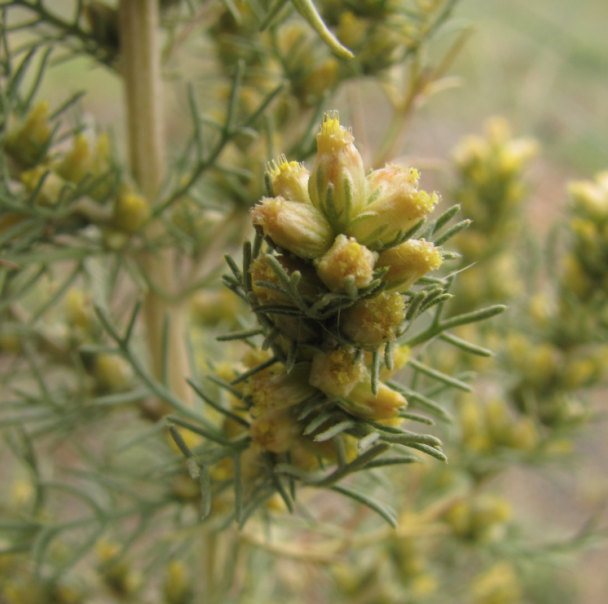
Neopallasia pectinata
Description: Perennial plants of the Asteraceae family. This plant can grow up to 40 cm. high. It is often found in groups forming a cushion. The stem is erect with a woody base and branched near the base. Leaves are alternate, pinnately divided, or deeply pectinate, greyish-green, and pubescent. The flowers are small capitules with a yellow disk floret found in terminal clusters or solitary. The fruits are akenes with a short pappus.
Ecology and adaptation: It grows on sandy or gravelly soil, rocky slopes, or dry steppes. Its long taproot system can access deep soil moisture. The pubescence on the leaves reduces transpiration. The woody base helps to survive summer heat and cold temperatures.
Traditional usage: The dried aerial parts are brewed into decoction to heal digestive issues and fevers.

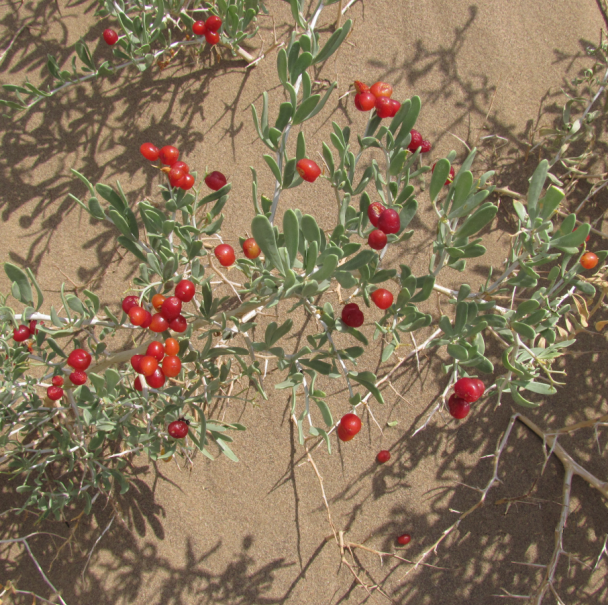
Nitraria sibirica
Description: Perennial plant of the Nitrariaceae family. It is a woody shrub that can grow up to 1.5 m high. Rigid, ligneous, stems often with sharp spines. Leaves simple, alternate, obovate to elliptic. They measure 1-3 cm long with a fleshy appearance. Flowers are small, white to pinkish, with 5 petals. The fruits are edible red drupes.
Ecology: N. sibirica grows in saline, alkaline, sandy soils, gravel deserts, and dry steppes. It sustains extreme aridity and direct sunlight exposure. Its flowers are pollinated by hymenopters and dipters end of spring. The seeds are dispersed by birds which allows them to spread far. As the birds eat the drupes, they pass through the digestive canal which helps break the dormancy.
Adaptation: Its succulent leaves store water and its thick cuticle prevents water loss by transpiration. It possesses a deep and extensive root system to access underground water. It can excrete excess salt through special glands located on the leaf surface.
Traditional usage: The fruits of N. sibirica are eatable. They are tonic and a good source of vitamins in the desert. It is also recommended to aid digestion.

Orostachys thyrsiflora
Description: Perennial plant of the Crassulaceae family. It produces a single erect thyrse or stalk. Its leaves are arranged in a rosette at the base. They are linear to ovate, fleshy, and ending with a small spine. The inflorescence is thyrse, a compound spike-like cluster of flowers.
Ecology and adaptation: O. thyrsiflora is found in the arid and semi-arid regions of Mongolia and Southern Sibéria. It grows in rocky plains, and gravel slopes, often exposed to the sun and the wind. The succulent leaves can store some reserve of water. The waxy cuticle minimizes water loss through transpiration. The deep root system accesses deep underground moisture. It adopts a monocarpic strategy. All the energy is focused on a single reproductive event. The rosette dies after flowering, but vegetative propagation may occur from the basal nodes. The flowers are pollinated by small insects such as flies or bees.
Traditional usage: This plant can be used externally to heal wounds, bruises, or burns. It might be boiled into a decoction to reduce inflammations.


Oxytropis glabra
Description: Perennial plant of the Fabaceae family. Pinnated leaves and mostly glabre with elliptic leaflets. The flowers are purple, violet, or blue. They are zygomorphic with 5 setals, 5 petals, and 10 stamens. The fruits are dehiscent, cylindrical, and ended with a hook.
Ecology: O. glabra grows sandy, gravelly soils or alluvial fans. The colorful flowers attract many insect pollinators. The stems can develop horizontally thus presenting the leaves from sunlight.
Adaptation: The long tap root system allows access to deep underground water. The trichomes of O. aciphylla, a close species living in the Gobi, can quickly capture moisture in the air and filtrate sunlight.
Traditional usage: The plant contains the swainsonine alkaloid. Therefore, it isn't safe to consume it. However, despite this toxicity, it is used as a topical anti-inflammatory to relieve local pains.
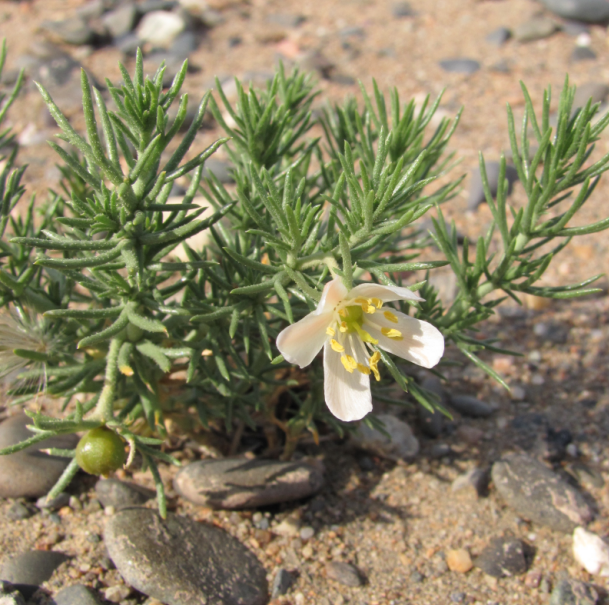

Peganum nigellastrum
Description: Perennial plant from the Zygophyllaceae family. Filiform and alternate leaves. Solitary and axiallary flowers with 5 petals. Globular fruits with 3-5 lobs splitting open at maturity to free numerous small black seeds.
Ecology: P. nigellastrum is suspected to be an allelopathic plant releasing chemicals in plants inhibiting other plant species' growth.
Adaptation: P. nigellastrum develops a deep taproot that allows access to underground water sources. Its lateral roots also help absorb moisture from a wide soil area. The small filiform leaves and the waxy coating minimize transpiration.
Traditional usage: Plants belonging to the genus Peganum are used as infusions or powders in case of indigestion or against intestinal worms.


Populus euphratica
Description: Deciduous tree of the Salicaceae family. The trunk is gnarled and twisted, with deeply furrowed bark. It might lean in the direction opposite to the wind. The leaves can differ greatly even within the same tree. The young leaves are linear to lanceolate, and the mature leaves are rather ovate and sometimes lobed. The flowers are dioecious and borne in catkins. The fruits are capsules that split to release small seeds with cotton-like hairs.
Ecology and adaptation: P. euphratica grows in riparian zones, oases, dry riverbeds, and intermittent floodplains. It can thrive in saline and alkaline soils. Its very deep tap root system can access underground water. It is often found in association with Tamarix sp., and Phragmites sp. It stores salt in vacuoles and sheds salt-laden leaves. It can also excrete salt through the roots. Seeds are mainly dispersed by wind. However, it can also regenerate from roots or even broken stems. P. euphratica plays an important ecological role in the Gobi Desert. The root system stabilizes soils and prevents desertification. It also provides habitat for birds, insects, and small mammals.
Traditional usage: The trees of the species P. euphratica are considered sacred. Its wood is tough and rot-resistant. It has been used for building shelters, fences, and ger frames. Deadwood is collected as fuelwood. The bark or leaves are sometimes infused to treat inflammation or wounds.


Prunus mongolica
Description: Prunus mongolica is a perennial shrub of the Rosaceae family. This small tree is densely branched and grows up to 1 m. tall. The branches are ligneous, spiny, and grayish-brown to reddish. Older wood is often cracked or gnarled. The leaves are alternate, simple, oblong to lanceolate, with serrated margins. The upper surface is green and smooth, the underside paler and slightly pubescent. Flowers are with five petals and numerous stamens. Drupes are ovoids, dry, not fleshy with a hard shell.
Ecology and adptation: The plant grows in gravel or sandy soils, rocky mountain slopes, and dry valleys. It is well-adapted to an extremely arid and cold climate. Its long tap root allows access to deep underground water. Its leaves are shorter than those of common Prunus thus allowing to prevent water loss through transpiration. Its velvety and dry drupes don't waste water to make them juicy. Their hard shell prevents water loss. The plant is deciduous allowing it to retract its nutrients before the cold season and fall into a physiological dormancy. P. Mongolica plays an important role as a soil stabilizer in sandy ecosystems. It also supports early pollinators in spring.
Traditional usage: The drups aren’t comestible. However, they have been used in small doses in traditional medicine to treat coughs, dry throat, and intestinal worms. It is an important plant for the cattle consumption. It is also an indicator of a healthy ecosystem.


Ptilotrichum canescens
Description: Perennial plant of the Brassicaceae family. It is a small cushion-like plant up to 20 cm high. The stems are woody at the base, becoming herbaceous at the tip, and branched to form a dense mat. The leaves are linear to oblanceolate, pubescent, and densely arranged along the stem. The inflorescences are dense, globular, and terminal at the end of the stem. The flowers are small, white, with 4 petals. The fruits are silicules that contain 2 seeds.
Ecology and adaptation: P. ptilotrichum grows in sandy, gravelly, and rocky soils. It is well adapted to drought and high solar radiation. Its small cushion architecture reduces transpiration, conserves warmth, and protects against wind. The short linear leaves decrease the surface area to reduce transpiration. The pubescence of the aerial part prevents excess water loss by transpiration and reflects the sunlight. The taproot allows access to deep underground moisture. The flowers are pollinated by insects such as flies, bees, or butterflies. The wingless seeds are primarily dispersed by gravity.
Traditional usage: The plant can be grazed by sheep and goats. It doesn't have known medicinal use. However, it is an indicator of dry but stable soil.


Rheum nanum
Description: Rheum nanum is a perennial plant of the Polygonaceae family. The stem is very short, making it one of the smallest species of the genus. The leaves are basal, large, and orbicular to reiniform. Petioles are long, fleshy, often reddish. Inflorescences are erect and composed of few flowers or a dense panicle. Flowers are small, greenish, white, or pinkish, with 6 tepals. The fruits are greenish to reddish-brown akenes.
Ecology and adptation: The plant grows in altitude, arid steppe, rocky desert margin, and desert-mountain zones of Mongolia. Its root system can penetrate deep into rocky soil allowing survival during episodes of drought. It also can store reserves of water. Its short architecture reduces exposure to wind and cold. Its large basal leaves arranged in a rosette maximize sunlight exposure while reducing wind impact. It is a pioneer plant that colonizes rocky, barren substrates. It helps stabilize soil and provide the necessary habitat for other plants to occupy the land. According to the nomads, its leaves are consumed by the mazaalai, the bear of the Gobi Desert.
Traditional usage: The roots can serve as a laxative. It can also be used to cure stomach ailments, liver issues, and wound healing.


Salsola passerina
Description: Perennial subshrub of the Amaranthaceae family. It grows up to 40 cm high. The stem is multibranched from the base. The lower part is often woody on older plants. Leaves are sessile, small, about 0.5-2 cm long and alternate. They are sparsely hairy and partially succulent. The inflorescence is dense, and glomerulate arranged on the upper leaves' axil. It contains tiny flowers with 5 membranous tepals and 5 stamens. The fruit is an urticle often with small wings.
Ecology: It grows in sandy soils or stony plains of semi-arid regions. It is tolerant to saline, alkaline, and nutrient-poor conditions. Its extensive root system helps stabilize de doil. Its dry urticles are dispersed by wind.
Adaptation: The plant is well adapted to dry conditions. It possesses small leaves to reduce transpiration and a long woody root system to absorb deep underground moisture. The woody base helps the plant survive winter frost and regrow after a period of droughts. The root system can exclude toxic sodium and chlorine. Its wide and spreading architecture protects the plant against the dry winds.
Traditional usage: The plant is considered a valuable forage plant for camels, goats, and sheep.

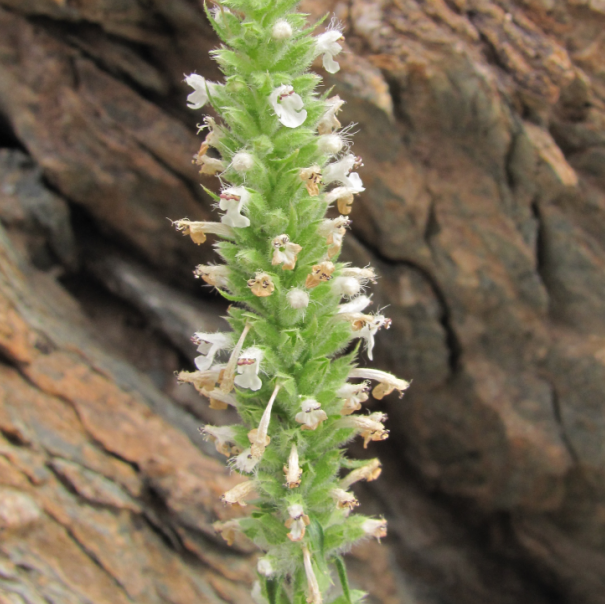
Schizonepeta annua
Description: Annual plant of the Lamiaceae family. The stem is slender, quadrangular, and sometimes pubescent. Leaves are opposite, dissected or pinnatifid. Inflorescences are terminal and dense, each nod bears a few flowers. Flowers are bilabiales, light pink or white, often with purplish marks. The calyx is tubular with 5 distinct lobes.
Ecology: Schizonepeta annua is a species found in arid and rocky regions, including parts of the Gobi Desert.
Adaptation: The plant possesses a deep root system to absorb water from a wide area. Its leaves are dissected to pinnatifid thus reducing water loss by transpiration. Its fine hairs protects against intense radiation. It can undergo a quick life cycle shortly after rainfall.
Traditional usage: The plant is used in decoctions or infusions against respiratory ailments, colds, and fevers.
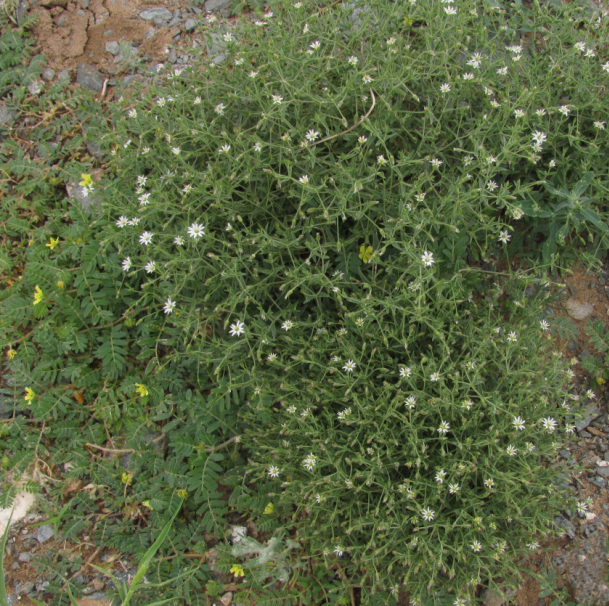

Stellaria dichotoma
Description: Stellaria sp. are annual or short-lived perennial plants of the Caryophyllaceae family. These plants can form mats with stems that are either prostrate or sometimes ascendant. The stems are often 4-angled. Leaves are opposite, simple, ovate, or lanceolate with short petioles or sessiles. Flowers are small, white, with 5 deeply bifid petals and 5 green sepals. They can hold up to 10 stamens and an ovary with 3 styles. Fruits are small capsules with 6 valves containing numerous brown seeds.
Ecology and adaptation: A few species of Stellaria can adapt to the harsh conditions of the Gobi Desert such as S. media and S. dichotoma. Their leaf size is often reduced to minimize water loss by transpiration. Their prostrate habit protects them against desiccation by wind. They usually grow in protected areas or under shrubs where the moisture stays longer.
Traditional usage: Stellaria sp. can be grazed by the cattle. Mongolian nomads don't seem to use these species for their medical benefits even though Stellaria media is recognized for its anti-inflammatory properties.
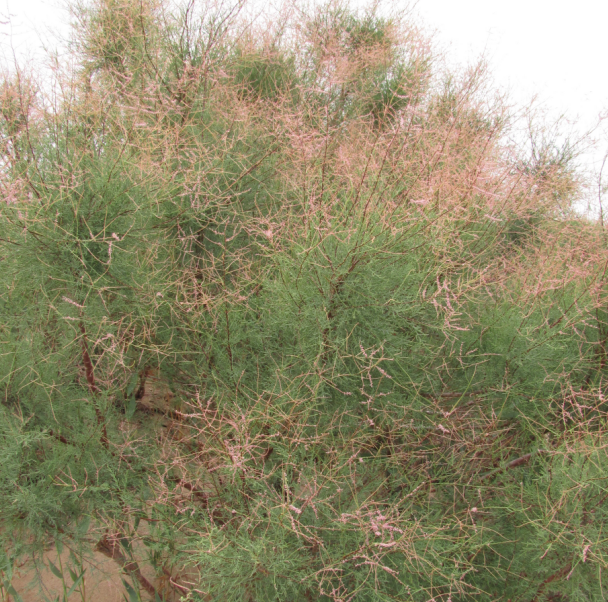
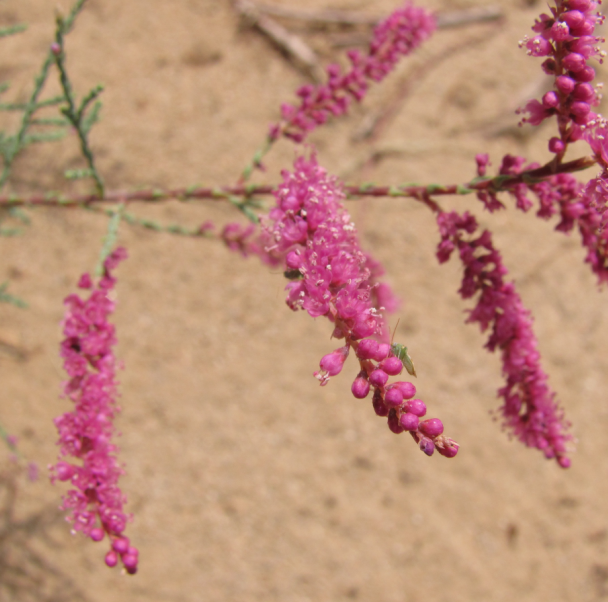
Tamarix sp.
Description: Plants of the genus Tamarix sp. are perennial shrubs or small trees from the Tamaricaceae family. A few different species grow in the Gobi Desert, such as T. ramosissima, T. chinensis, T. hispida, and T. leptostach. Their stems are usually gray to brownish and can even be red to purple in the case of T. hispida. Their leaves are scaly with a green bluish color. Their flowers are white, pink to purple. Those of T. ramosissima appear paler than those of the other genus.
Ecology: T. ramosissima is found in a broad range of habitats including dry riverbeds, alluvial fans, saline depressions, and desert edges. T. chinensis is localized in the eastern part of the desert and appears to be less salt tolerant than the other species. T. hispida is more rare. This species can grow in oases or dry riverbeds of the southern Gobi Desert. T. leptostachya is also rare but adapted to a more saline environment than the others. Tamarix sp. are adapted to saline environment. They can excrete an excess of salt on the leaves through specialized glands. Their dense architecture helps to trap sediments and retain moisture. In this regard, they play an important role in stabilizing desert soil and preventing erosion. They produce large amounts of seeds allowing them to grow in groups and form oases where conditions allow it. They can also reproduce vegetatively via root suckers.
Traditional usage: Nomads harvest deadwood and prune branches as fuelwood. The branches can also serve as temporary fences or windbreaks for the cattle. Their infusion can be applied to disinfect wounds in animals.

Thermopsis mongolica
Description: Perennial plant of the Fabaceae family. The stem is erect and mostly unbranched covered with a thin duvet. Leaves are composed with 3 elliptic leaflets. Leaflets are pubescent with short petioles. Flowers are zygomorphic, and yellow, placed on top of the raceme. Fruits are linear podes of 5 cm containing multiple seeds.
Ecology: T. mongolica grows in dry, sandy, or stony steppes of Central Asia. It tolerates salty and alkali conditions. Its yellow flowers attract pollinators such as bees and hoverflies. Seeds are hard and can remain dormant for years. Its root system grows nodules for symbiotic fixation of nitrogen.
Adaptation: The plant has good water management. Its hairy greyish leaves help conserve moisture and reflect sunlight. The leaflet's small surface area reduces transpiration. It stores water and nutrients in its perennial rhizomes. The rhizomes allow regrow after a drought season or even fire. They also support clonal reproduction to expand the colony in disturbed soil.
Traditional usage: The aerial dried part of the plant is used against cough and respiratory congestion despite its low toxicity.
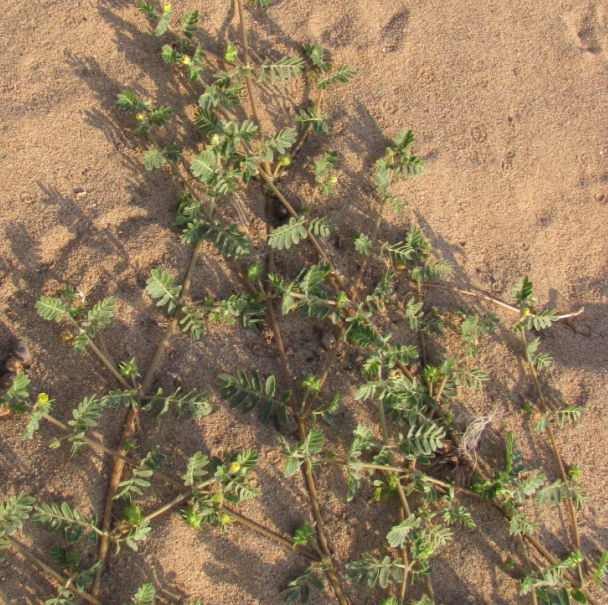

Tribulus terrestris
Description: Annual plant of the Zygophyllaceae family. Stems form a radiating mat with multiple embranchments from the base. They can grow up to 1 m long. Opposite compound leaves with 4-8 pairs of oblong to lanceolate leaflets. Leaflets are pubescent. Solitary flowers grow from leaf axils with 5 petals and 10 stamens. Fruits are schizocarp-containing seeds that break into 5 mericarps bearing spines.
Ecology: T. terrestris is a pioneer species. It is among the first to colonize a barren land. Its sprawling growth helps reduce wind erosion and provides habitats for insects. Its yellow flowers attract pollinators.
Adaptation: Its sprawling protects it against strong winds and conserves moisture by staying close to a cooler surface. Its deep taproot allows access to deep moisture reserves. It also possesses hairy leaves that minimize water loss and partly reflect sunlight. Its spiky burrs are dispersed by zoochory. It attaches to hooves or fur enabling a large dispersal.
Traditional usage: The plant is a diuretic and has been used against kidney and urinary disorders. It is also believed to relieve muscle or joint pain and to restore the body's energy system.
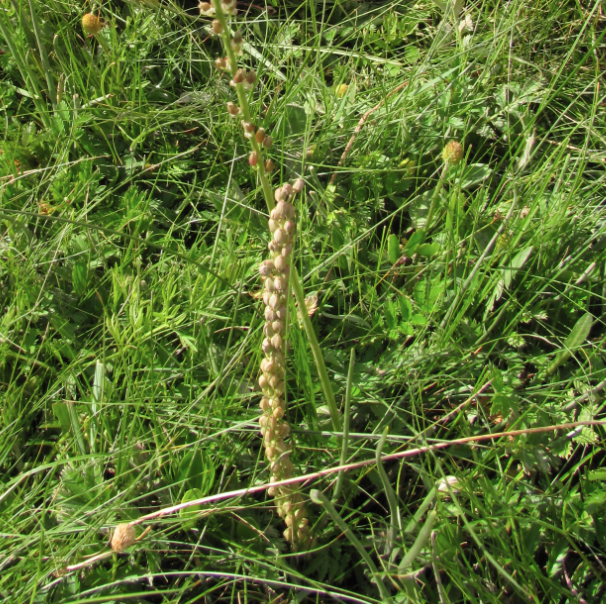
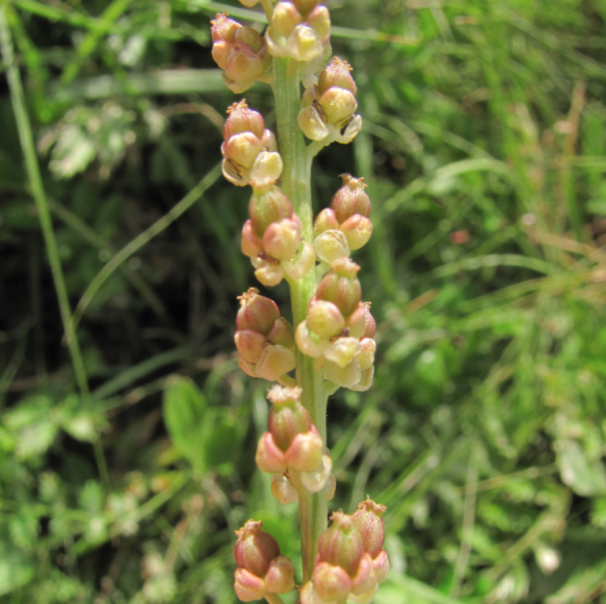
Triglochin maritima
Description: Perennial plant of the Juncaginaceae. Stems are erect. The unbranched flowering stalks rise above the basal leaves. The leaves are linear, semi-terete, and fleshy. The inflorescence rise above the leaves. It is terminal, raceme, and bears numerous small greenish or purplish flowers. The flowers are directly attached to the stalk. They are bisexual with 6 tepals, 6 stamens, and 3 carpels. The fruits are schizocarps that split into 3 nutlets.
Ecology and adaptation: T. maritima tolerates well saline and alkaline soils. It grows in saline depressions and wet edges of inland basins. During period of droughts, it grows in microhabitats with shallow water. Its succulent leaves can store water. The plant has developed a mechanisme of sequestration and excretion of salt. The narrow stomata and thick cuticle reduce water loss by transpiration.
Traditional usage: There are no known traditional uses for this plant. It can eventually be grazed by cattle. However, it contains cyanides that can be harmful.
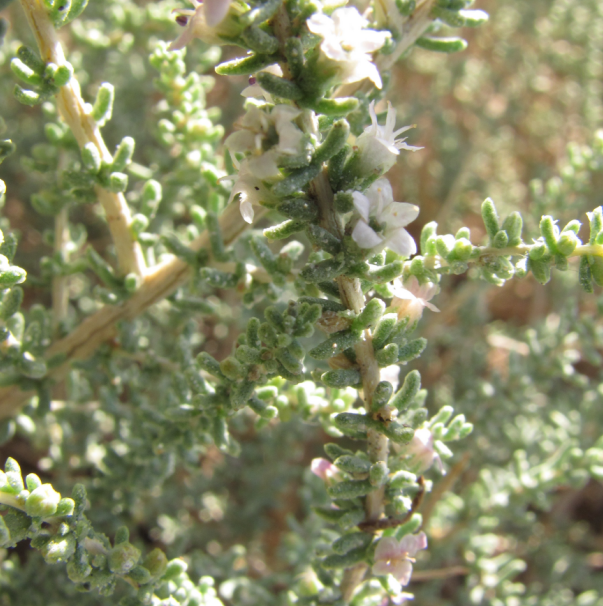
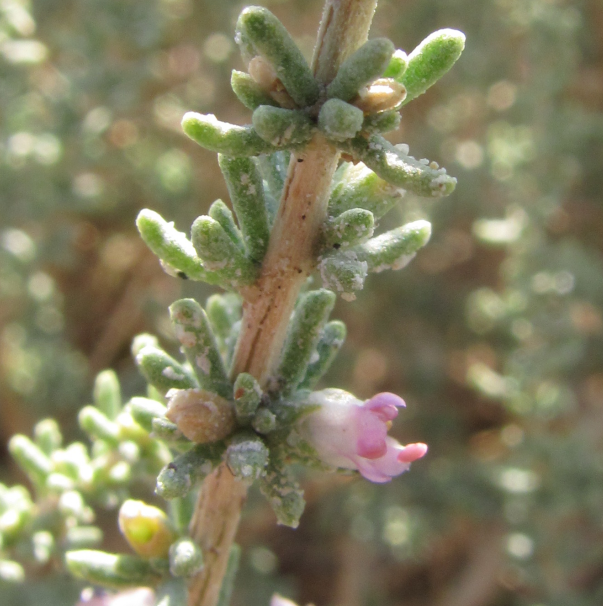
Zygophyllum album
Description: Perennial and deciduous shrub of the Zygophyllaceae family. The stems are woody with many ascending branches. Leaves are succulent, linear to oblong, smaller than Z. xanthoxylum. Flowers are small, white, borne in clusters, with 5 petals. The fruits are capsules that contain many seeds.
Ecology: Z. album is well adapted to arid and semi-arid steppes and deserts. It grows in sandy or rocky soils. Its keeled fruits are dispersed by wind, allowing the plant to colonize open, wide, areas such as plains and steppes.
Adaptation: The deep root system allows access to underground water. The small size of the leaves and their thick cuticle prevent excessive loss of water by transpiration. The fleshy, succulent leaves can store water allowing the plant to survive for a long period without rainfall. Z. album can concentrate the salt in its leaves and shed them to maintain a good salt balance.
Traditional usage: The leaves and roots of the plants are used to treat gastrointestinal disorders. The leaf extract can also be used for its anti-inflammatory properties to reduce inflammation, arthritis, and joint pains. Also, this plant contains antimicrobial properties and can treat infections.

Zygophyllum rosovii
Description: Perennial plant of the Zygophyllaceae family. Young stems can be reddish-green and fleshy, whereas older stems are woody at the base. Leaves are opposites, fleshy, and bipartites. The leaflets are oval to oblong and succulent with a waxy cuticle. Flowers are solitary and axillary. Their 5 petals are yellow with a diameter ranging up to 1.5 cm.
Ecologyand adaptation: Z. rosovii grows in sandy or gravelly soil, saline plains, or rocky outcrops. Its deep and extensive root system enables access to deep underground moisture. The succulent leaves are adapted to water storage and the thick waxy cuticle prevents water loss through transpiration. The plant can survive in a saline environment through a salt exclusion mechanism at the root level. It can also sequestrate ions into the vacuoles. Flowers can bloom shortly after a moisture event. They are short-lived but produced frequently through the saison. The woody base and low growth protect the plant against the wind and stabilize the soil.
Traditional usage: The plant has limited ethno-medical uses. However, camels and sheep may consume it during dry seasons. Due to its succulent nature, it provides some hydration and minerals, though it's not highly nutritious.


Zygophyllum xanthoxylum
Description: Perennial and deciduous shrub of the Zygophyllaceae family. The stems are woody with compact thorny branches. Their texture is smooth and somewhat elastic. Leaves are small needle-like scales with an entire margin. Flowers are bright yellow, solitary, with 5 petals. The fruits are capsules that turn yellow at maturity.
Ecology: Z. xanthoxylum grows under similar conditions than Z. album. It thrives in sandy or rocky soils. Its keeled fruits are dispersed by wind, allowing the plant to colonize open, wide, areas such as plains and steppes.
Adaptation: The deep root system allows access to underground water. The small needle-like shape of the leaves and the thick cuticle prevent excess loss of water by transpiration. Their sunken stomata decrease the evaporation rate by trapping humidity around it. Its deciduous nature allows it to shed leaves in time of droughts thus conserving water resources. The thorns serve as a defense mechanism against grazing animals.
Traditional usage: The leaves and roots of the plants are used to treat gastrointestinal disorders. The leaf extract can also be used for its anti-inflammatory properties to reduce inflammation, arthritis, and joint pains.
